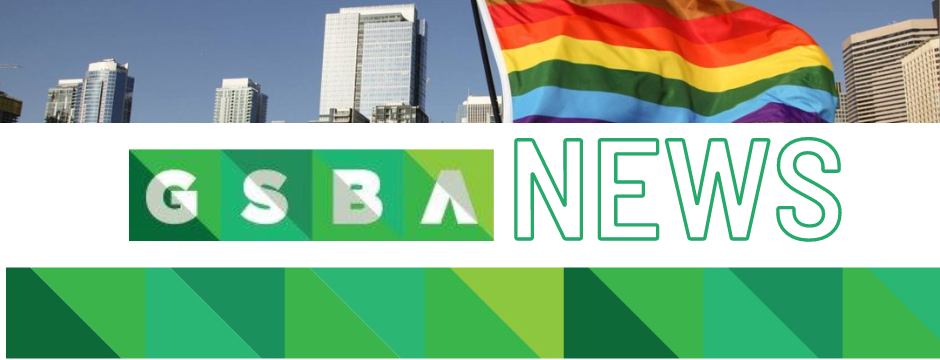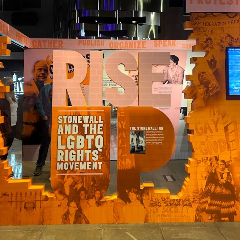 As soon as visitors to the Museum of Pop Culture (MoPop) reach the top of the second floor stairs, they’re faced with large, blocky letters in bright orange proclaiming “Rise Up: Stonewall and the LGBTQ Rights Movement.” On loan from Washington D.C.’s Newseum, this exhibit uses artifacts, texts, and multimedia to tell the story of America’s LGBTQ+ Civil Rights Movement. As visitors make their way through the exhibit, one thing becomes inextricably clear: the very nature of this exhibit, the platforming of LGBTQ+ histories at a venue like MoPop, is a milestone in itself.
As soon as visitors to the Museum of Pop Culture (MoPop) reach the top of the second floor stairs, they’re faced with large, blocky letters in bright orange proclaiming “Rise Up: Stonewall and the LGBTQ Rights Movement.” On loan from Washington D.C.’s Newseum, this exhibit uses artifacts, texts, and multimedia to tell the story of America’s LGBTQ+ Civil Rights Movement. As visitors make their way through the exhibit, one thing becomes inextricably clear: the very nature of this exhibit, the platforming of LGBTQ+ histories at a venue like MoPop, is a milestone in itself.
The exhibit opened during Pride Weekend on June 26 and takes guests through a chronological breakdown of important eras, political battles, and pop culture touchstones before highlighting local organizations and leaders in the Pacific Northwest’s LGBTQ+ community.
From the Mattachine Society, to the dawn of LGBTQ+ press and the critical role Gay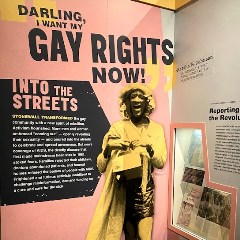 and Lesbian newspapers played in our community, Rise Up explores the many ways LGBTQ+ people found each other and built community in the first half of the 20th century. From here, the exhibit demonstrates how out of community grew activism, and how Lesbians, QTBIPOC communities, transgender, and gender-diverse people wrestled with prejudice and worked to carve our their own intentional spaces – including the founding of S.T.A.R. by Marsha P. Johnson and Sylvia Rivera. Johnson’s involvement with the Stonewall Uprising is featured prominently, though Rise Up is clear that details about who threw the first brick on June 28, 1969 remain contested. Old newspaper clippings covering the Stonewall Uprising are included in this display, as well as little-known histories of LGBTQ+ activism before 1969.
and Lesbian newspapers played in our community, Rise Up explores the many ways LGBTQ+ people found each other and built community in the first half of the 20th century. From here, the exhibit demonstrates how out of community grew activism, and how Lesbians, QTBIPOC communities, transgender, and gender-diverse people wrestled with prejudice and worked to carve our their own intentional spaces – including the founding of S.T.A.R. by Marsha P. Johnson and Sylvia Rivera. Johnson’s involvement with the Stonewall Uprising is featured prominently, though Rise Up is clear that details about who threw the first brick on June 28, 1969 remain contested. Old newspaper clippings covering the Stonewall Uprising are included in this display, as well as little-known histories of LGBTQ+ activism before 1969.
With different segments of the exhibits, visitors can take quizzes and share their opinions on interactive screens. One quiz asks visitors their opinion on the Masterpiece Cakeshop v. Colorado Civil Rights Commission case while another asks people to guess what year Massachusetts legalized same-sex marriage.
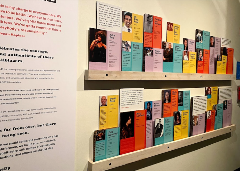 Once guests take-in artifacts from the lavender scare, Anita Bryant’s “Save the Children” campaign, the 1979 March on Washington, the AIDS epidemic and ACT UP movement, the US Supreme Court’s 2015 decision on marriage equality, North Carolina’s 2016 anti-trans bathroom bill, and more, Rise Up pivots from history to contemporary activism and representation in pop culture – along with a display explaining the LGBTQ+ acronym, reclamation of the word “queer,” and other common terms. Here, local leaders like Aleksa Manila and D. Dynasty (drag persona of GSBA Board Member Dominique Stephens) are featured, having loaned costumes to MoPop.
Once guests take-in artifacts from the lavender scare, Anita Bryant’s “Save the Children” campaign, the 1979 March on Washington, the AIDS epidemic and ACT UP movement, the US Supreme Court’s 2015 decision on marriage equality, North Carolina’s 2016 anti-trans bathroom bill, and more, Rise Up pivots from history to contemporary activism and representation in pop culture – along with a display explaining the LGBTQ+ acronym, reclamation of the word “queer,” and other common terms. Here, local leaders like Aleksa Manila and D. Dynasty (drag persona of GSBA Board Member Dominique Stephens) are featured, having loaned costumes to MoPop.
The feature “Icons of Seattle” spotlights several regional LGBTQ+ leaders including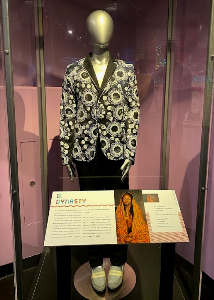 GSBA Members David Neth, Dr. Bish Paul, Adra Boo, Sue Bird of the Seattle Storm, Marsha Botzer, and other leaders such as Speaker Laurie Jinkins, Cal Anderson, and Justice G. Helen Whitener are also included. A few feet away, MoPop highlights regional organizations and businesses continuing to work on behalf of LGBTQ+ civil rights, including GenPride, Babeland, Entre Hermanos, Gay City, Seattle Pride, UTOPIA WA, Three Dollar Bill Cinema, Seattle Men’s & Women’s Chorus, Bailey Boushay House, Lifelong, Gender Justice League, and more.
GSBA Members David Neth, Dr. Bish Paul, Adra Boo, Sue Bird of the Seattle Storm, Marsha Botzer, and other leaders such as Speaker Laurie Jinkins, Cal Anderson, and Justice G. Helen Whitener are also included. A few feet away, MoPop highlights regional organizations and businesses continuing to work on behalf of LGBTQ+ civil rights, including GenPride, Babeland, Entre Hermanos, Gay City, Seattle Pride, UTOPIA WA, Three Dollar Bill Cinema, Seattle Men’s & Women’s Chorus, Bailey Boushay House, Lifelong, Gender Justice League, and more.
Rise Up honors the legacy of LGBTQ+ activism and gives a soap box to these histories often overlooked. But most of all, the exhibit not only educates potential allies, but fulfills the important need of reminding us how far we’ve come and to not take for granted the freedoms we have today – even while critical battles continue to be fought.
Rise Up closes on Sunday, Sept. 12. GSBA also visited MoPop as a part of our Travel OUT series in June, interviewing and touring the museum with Sr. Communications Manager Michael Cole-Schwartz. Other exhibitions currently on display at MoPop include Heroes & Villains: The Art of the Disney Costume, Infinite Worlds of Science Fiction, Indie Game Revolution, and more.


